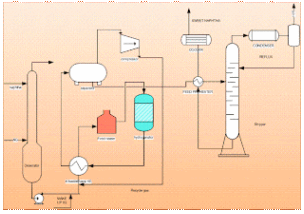The test is not applicable to water containing an appreciable amount of calcium and magnesium as these are also titratable with EDTA. The test is generally applicable to water hardness less than 20mg/l as CaCO3.
Outline of the method – a measured excess of Std barium chloride solution is added to the sample and the excess of barium chloride is estimated by titration against EDTA.
Reagents
1. Dil HCL acid – 0.5N
2. Std barium chloride sol (0.04N ) – dissolve 4.886g of barium chloride dihydrate in distilled water and make up to 1 litre. One millilitre of the solution is equivalent to 1.92mg of sulphate (SO4)
3. Buffer solution – dissolve 67.5f of ammonium chloride in 570ml of ammonium hydroxide (Sp Gr 0.92) and dilute with distilled water to 1 lit.
4. Erichrome black T indicator solution.
5. Std EDTA sol 0.02N
Procedure –
Pipette 10ml of the sample into a porcelain dish and acidify with 1ml of dilute HCl. Add exactly 10 ml of standard barium chloride acid. Add exactly 10ml of Std barium chloride solution and stir well. Add 1ml buffer solution and several drops of Erichrome black T. Titrate with Std EDTA solution to a blue colour which does not change with the addition of further drops of indicator solution.
Calculation
Sulphates (as SO4), mg/l = 192(10-V/2)
Where
V = volume of Std EDTA solution
Sulphites determination
8) Sulphites testing procedure:
The sample is titrated against Std iodate-iodide sol using a starch indicator.
Reagents required:
- Dil HCl acid:- Add 200ml of concentrated hydrochloride acid to 100ml of distilled water.
- Starch indicator solution:- Mix starch (5g) and mercuric iodide (0.01g) with distilled water (30ml). Makeup to one litre using boiling distilled water. Boil for 3min allow cooling and decanting off the supernatant clear liquid.
- Std iodate-iodide solution:- Weigh accurately 0.713g of potassium iodate and dissolve in about 150ml of distilled water. Add 7g of potassium iodide and 0.5g of sodium bicarbonate, when dissolved dilute the solution to exactly 1lit.
Procedure:
- Since sulphite tends to be oxidized in content with air, great Care shall be exercised in sampling. The following procedure shall be adopted:
- Collect the sample by running it to the bottom of the 250ml bottle but allowing about eight to ten times the volume of the bottle to run to waste before taking the sample.
- For this test, a filtered sample shall not be used unless the suspended matter is present containing interfering substance, for example, iron oxide, in which case insert a filter in the sample line.
- Measure 2ml of HCl acid into a 350ml porcelain basin and add 100ml of the sample and 1ml starch indicator to it. Titrate immediately with std iodate-iodide solution, stirring continuously, until a faint permanent blue colour is obtained.
Calculation:
- Sulphite (SO3), mg/l = 8 V
- V (ml)= Std iodate-iodide solution volume consumed.
Related Topic click here
- Petrochemical Products From Propylene | Types Of Pressure Gauges | Types Of Reactors Used For Chemical Reactions And Chemical Process
- Printing Machine And Devices | Propellers Of A Ship
- Predesulphurization Of Raw Naphtha Process Plant Flow Sheet
- Phosphoric Acid Per Day Flow Sheet Of Dihydrate Process
- Types Of Phenol Manufacturing Process
- Cholorobenzene And Caustic Process For Phenol Production | Phenol Production By Benzene Sulfonation Process
- Bin Blender Applications
- Operating Procedure For Liquid-Liquid Extraction In Packed Column


